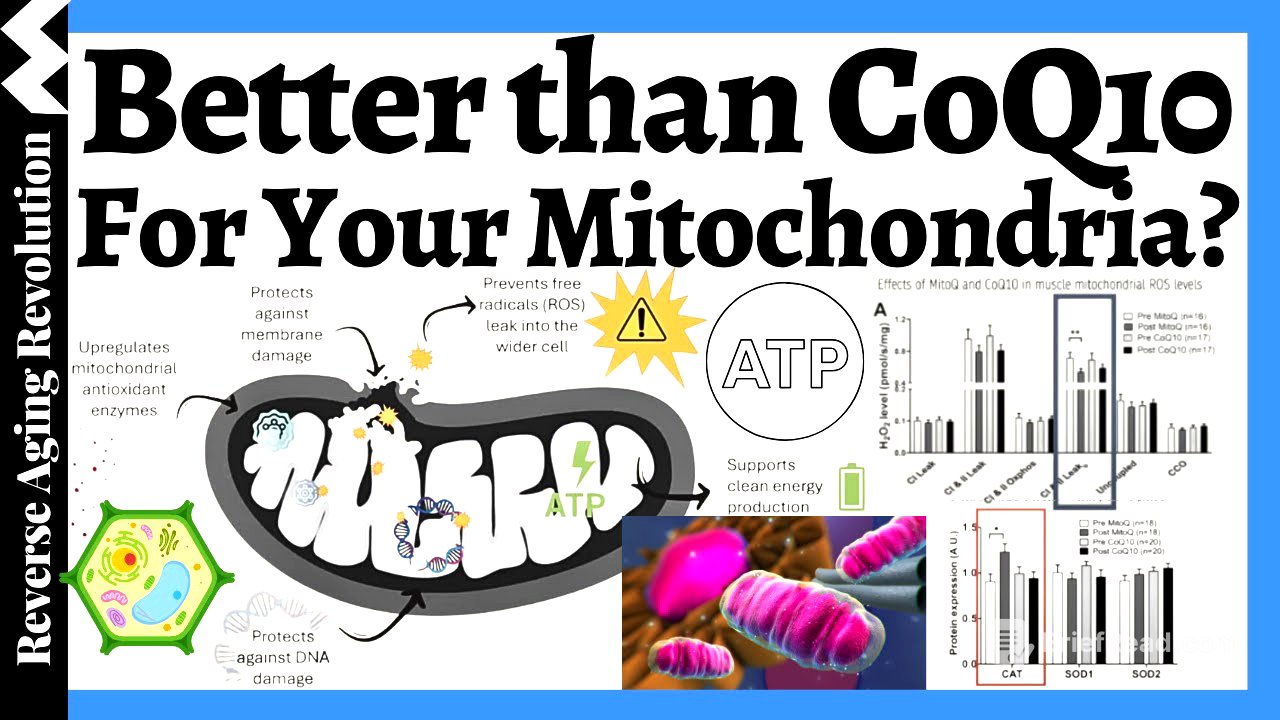TLDR;
This video discusses the role of mitochondria in aging and how to protect them. It explains how mitochondria produce energy but also generate damaging free radicals. Protecting mitochondria can slow down aging and maintain energy levels. Calorie restriction and certain supplements can help mimic this effect. MitoQ, a specially engineered antioxidant, can effectively target and protect mitochondria. Clinical studies demonstrate MitoQ's benefits for vascular function, exercise performance, and various conditions like multiple sclerosis and diabetes.
- Mitochondria are the powerhouse of cells, producing energy but also generating damaging free radicals.
- Protecting mitochondria can slow down aging and maintain energy levels.
- Calorie restriction and certain supplements can mimic the benefits of calorie restriction.
- MitoQ is a specially engineered antioxidant that can effectively target and protect mitochondria.
- Clinical studies demonstrate MitoQ's benefits for vascular function, exercise performance, and various conditions.
Introduction to Mitochondria and Free Radicals [0:07]
Mitochondria are the powerhouses of cells, responsible for 95% of the body's energy production. However, this process also generates free radicals, damaging molecules that attack proteins, DNA, and lipid membranes. Damage to DNA can hinder cell replication and regeneration, while damaged proteins can cause cellular dysfunction. Mitochondria are exposed to 10 times more free radicals than the rest of the cell, requiring extra protection. It's challenging to protect mitochondria because they are a privileged area of the cell with a membrane that is hard to penetrate, limiting the effectiveness of many supplements and antioxidants.
The Impact of Mitochondrial Damage on Aging [2:22]
As mitochondria produce energy, they also create free radicals, leading to damage and a decline in energy production by up to 10% per decade. Protecting mitochondria can slow down the aging process and maintain optimal energy levels. Energy loss is often noticeable in the brain, heart, and muscles, which are high-energy-demand areas. Cells are like plants making energy but also producing pollution (oxidative stress) that damages the surrounding environment. The damage is a slow process, often unnoticed until it manifests as conditions like diabetes, fatty liver, or heart disease.
Calorie Restriction and Mimetic for Mitochondrial Health [4:53]
Calorie restriction, limiting calorie intake, has been shown to extend lifespan in various organisms by making cells more efficient in energy use. Calorie restriction mimetics, like resveratrol, aim to mimic these benefits. These mimetics work on pathways involving mitochondria and oxidative stress, decreasing reactive oxygen species (ROS) to prolong life. MitoQ works on these pathways, optimizing energy production and minimizing oxidative stress.
Sources of Oxidative Stress [7:33]
Mitochondria produce the most oxidative stress in the body, but oxidative stress also comes from various sources. Endogenous sources include mitochondrial disorders, metabolism issues (like being overweight or having high blood glucose), inflammation, and immune system dysfunction. Exogenous sources include radiation, xenobiotics, bacteria, smoking, and alcohol abuse. Minimizing oxidative stress from both mitochondria and these external factors is important.
How Antioxidants Work [8:36]
Antioxidants combat oxidative stress by donating electrons to reactive oxygen species (free radicals), which have unpaired electrons and are highly reactive. By donating an electron, antioxidants stabilize these free radicals, preventing them from damaging cells. MitoQ functions as an antioxidant by providing an extra electron to neutralize oxidative stress.
MitoQ: A Targeted Antioxidant for Mitochondria [9:37]
MitoQ is a specially engineered antioxidant designed to penetrate the mitochondrial membrane, which is difficult for most antioxidants. Developed in New Zealand, MitoQ is designed to deliver CoQ10, a natural antioxidant produced by mitochondria, directly into the mitochondria. As people age, they produce less CoQ10, making MitoQ a valuable supplement. MitoQ has a positively charged triphenylphosphonium ion that allows it to be drawn into the negatively charged mitochondria.
MitoQ's Mechanism and Benefits [10:51]
MitoQ's structure includes a CoQ10 component for donating electrons and a triphenylphosphonium ion for targeting mitochondria. MitoQ protects mitochondria from free radical damage, prevents free radicals from leaking into the cell, protects against membrane damage, upregulates natural antioxidants, protects against DNA damage, and supports clean energy production. By enabling energy production with less oxidative stress, MitoQ helps maintain cellular health.
MitoQ vs. CoQ10: A Comparative Study [13:16]
CoQ10 is a good antioxidant but is poorly absorbed and doesn't effectively reach the mitochondria. A study comparing MitoQ and CoQ10 (in the form of ubiquinol) showed that MitoQ decreased reactive oxygen species in muscle mitochondria, while CoQ10 did not have a significant effect. MitoQ also increased catalase, a key antioxidant enzyme, while CoQ10 did not. This study provides evidence that MitoQ effectively targets mitochondria, unlike CoQ10.
Clinical Studies on MitoQ: Vascular Function [15:39]
MitoQ has been extensively studied, with about 24 completed clinical studies and another 30 in the pipeline, supported by hundreds of millions of dollars in research. One pivotal study focused on vascular function, showing that MitoQ improved vasodilation by 42% in older adults (60-79 years) after six weeks. MitoQ also decreased oxidized LDL cholesterol, a key biomarker for heart health and aging, and reduced artery stiffening. These results indicate MitoQ's benefits for heart and arterial health.
Clinical Studies on MitoQ: Exercise Performance [18:59]
Exercise is highly beneficial for health, and MitoQ can enhance its effects. A study showed that MitoQ improved exercise performance in middle-aged individuals, making difficult time trials easier to complete. Participants had better energy output and less inflammation (measured by isoprostanes) after exercise. MitoQ can help muscles recover quicker by reducing inflammation.
Synergistic Effects of MitoQ and Exercise [20:46]
MitoQ and exercise have synergistic effects on health. A study with hypertensive older adults showed that MitoQ alone improved blood pressure and reduced oxidative stress markers. Combining MitoQ with moderate exercise resulted in even more powerful benefits, demonstrating a synergy between the two. This highlights that MitoQ can enhance the benefits of exercise, even when exercise is challenging.
MitoQ and Exercise in Multiple Sclerosis [22:03]
A pilot study explored the effects of MitoQ and exercise on biomarkers in individuals with multiple sclerosis. The study found that MitoQ, combined with a moderate exercise regimen, reduced inflammation markers (like IL-6) in premenopausal women. The effects were less pronounced in postmenopausal women, possibly due to lower estrogen levels and increased inflammation associated with menopause. The study suggests that protecting mitochondria and exercising before menopause is particularly beneficial.
MitoQ and Diabetes Prevention [25:27]
A recent study investigated MitoQ's potential in preventing the early stages of diabetes. The researchers mimicked high sugar and fat levels in the bloodstream using a bolus lipid challenge. They found that MitoQ helped maintain insulin sensitivity and increased glucose uptake in muscle cells, reducing oxidative stress and inflammation. This suggests that MitoQ may help prevent the onset of diabetes by improving insulin function and glucose metabolism.
MitoQ and Brain Health: Animal Study on Air Pollution [27:40]
An animal study examined the effects of MitoQ on brain health in mice exposed to air pollution. Mice given MitoQ in their water showed improved cognitive function and mood, as well as better lung function. MitoQ helped maintain mitochondrial function in the brain and lungs, protecting against the harmful effects of air pollution. This study suggests that MitoQ can protect against the cognitive and respiratory effects of air pollution.
Ongoing and Future Studies [29:29]
Several ongoing and future studies are exploring the potential benefits of MitoQ for various conditions. These include studies on fatigue in multiple sclerosis, brain diseases like schizophrenia and frailty (related to Alzheimer's), neurovascular function, and ALS. A study on long COVID is also underway. These studies aim to further understand and demonstrate the potential of MitoQ in improving health and combating age-related diseases.









